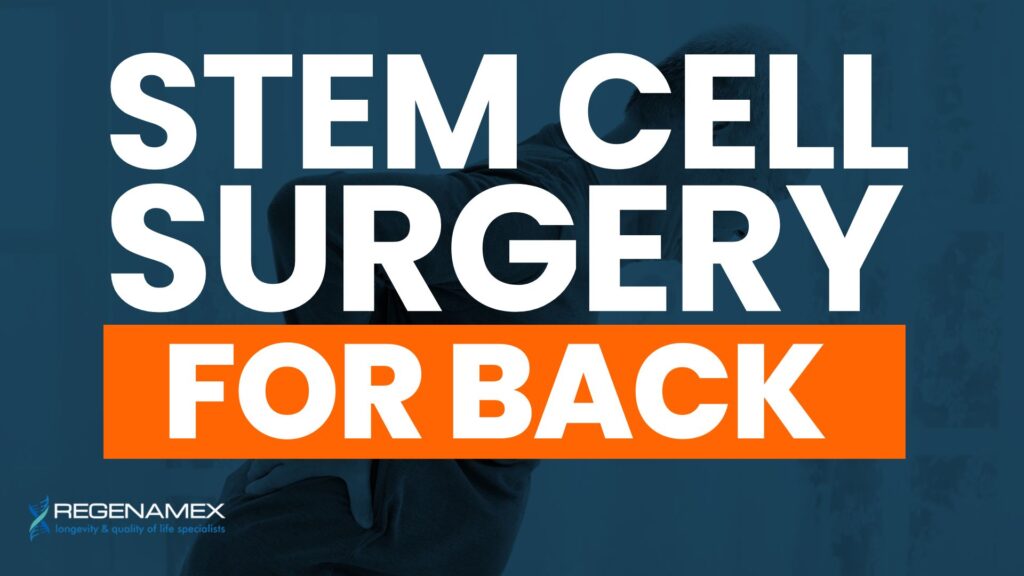
Stem Cell Surgery for Back: A Regenerative Alternative to Invasive Procedures
Stem cell surgery for back is redefining how chronic spine conditions are managed, offering patients a safer and less invasive alternative to traditional spinal operations. Instead of cutting or fusing bone, this approach harnesses the power of mesenchymal stem cells (MSCs), which have the ability to reduce inflammation, repair tissue, and promote natural regeneration. By directly targeting the damaged discs, joints, or connective tissue, stem cell therapy goes beyond masking pain and focuses on restoring mobility and function. For individuals living with debilitating back pain caused by disc degeneration, herniation, or spinal arthritis, stem cell surgery represents a modern, science-backed option that reduces downtime and delivers long-lasting relief.
At Regenamex, a licensed regenerative medicine clinic in Mexico, patients from around the world have access to these innovative treatments in a regulated environment overseen by COFEPRIS, the country’s health authority. By exclusively using MSCs sourced from ethically donated placental tissue and Wharton’s jelly, Regenamex ensures both safety and potency. This ethical sourcing avoids the limitations of bone marrow or fat-derived cells, providing patients with higher therapeutic potential. Combined with transparent pricing, comprehensive aftercare, and additional therapies like PRP, HGH, and exosomes, Regenamex has become a trusted destination for those seeking cutting-edge regenerative alternatives to invasive back surgery.
Understanding Back Pain and Its Challenges

Back pain remains one of the most widespread health problems globally, affecting people of all ages and limiting their ability to work, exercise, or even enjoy daily activities. Conditions such as degenerative disc disease, herniated discs, spinal stenosis, and arthritis are among the leading causes of chronic back pain, and they can trigger inflammation, nerve compression, and progressive tissue deterioration. Over time, this leads to stiffness, reduced range of motion, and significant declines in quality of life. For many patients, persistent back pain also contributes to sleep problems, anxiety, and loss of independence, highlighting the need for treatments that address both symptoms and underlying causes.
Traditional medical solutions—pain medications, steroid injections, and physical therapy—can provide relief, but their effects are often temporary. Surgery, while considered when conservative measures fail, is associated with long recovery times, high costs, and risks of complications like infection or failed fusion. In some cases, even after surgery, pain persists or new spinal problems emerge. This gap in effective long-term options has fueled interest in regenerative approaches such as stem cell surgery for back. By repairing rather than removing or altering tissues, stem cells offer hope for patients seeking sustainable recovery without the drawbacks of invasive procedures.
How Stem Cell Therapy for Back Pain Works
Stem cell therapy for back pain works by leveraging the regenerative properties of MSCs to repair and strengthen spinal tissues. These cells can differentiate into bone, cartilage, and other connective tissues, making them ideal for targeting degenerative or injured spinal structures. When injected into damaged areas, MSCs release bioactive molecules that calm inflammation, stimulate the production of collagen, improve blood circulation, and encourage the regeneration of healthy tissue. This process not only reduces pain but also promotes functional healing, giving patients a real chance at restoring mobility and flexibility.
At Regenamex, every step of the procedure is performed with precision. Using advanced imaging technologies such as ultrasound or fluoroscopy, physicians deliver the stem cells directly into the affected discs or joints, ensuring accurate placement. This guided approach minimizes risk and maximizes the therapeutic effects of the cells. Unlike surgery, which often removes or alters structures, stem cell injections for spine stimulate natural repair and strengthen the body’s own ability to heal. For patients with herniated discs, degenerative conditions, or spinal arthritis, this regenerative strategy provides a safe and highly effective alternative to conventional operations.
Stem Cell Injections for Spine vs. Traditional Surgery
When comparing stem cell injections for spine conditions with traditional surgical approaches, the differences highlight why so many patients are turning to regenerative care. Conventional surgery often involves invasive cutting, bone fusion, or disc removal, which not only alters spinal anatomy but also requires months of rehabilitation. Stem cell therapy, on the other hand, is minimally invasive, requiring only targeted injections that stimulate healing without permanently changing spinal structures. Patients who undergo regenerative treatments typically return to normal activity in days or weeks, while surgical recovery can take several months.
| Aspect | Stem Cell Therapy for Back | Traditional Spine Surgery |
|---|---|---|
| Invasiveness | Minimally invasive injections | Open or fusion surgery |
| Recovery Time | Days to weeks | 4–6 months |
| Pain Relief | Natural, progressive reduction | Immediate but rehab required |
| Risk Level | Low (mild soreness/swelling) | Higher (infection, nerve damage) |
| Longevity | Can delay/prevent surgery for years | May require revision surgery |
| Cost (U.S. vs. Mexico) | 50–70% less at Regenamex | $40,000+ in U.S. |
Patients often choose stem cells for herniated disc and other spinal conditions because the results last longer, the risks are lower, and the treatments allow them to avoid the life-changing limitations that sometimes follow surgery.
Stem Cells for Herniated Disc: A Targeted Approach
A herniated disc occurs when the soft cushion between vertebrae bulges or ruptures, pressing on nearby nerves and causing pain, numbness, or weakness. Traditional surgical options such as discectomy or spinal fusion remove part of the disc or permanently alter the spine’s structure, often leading to further complications. Stem cells for herniated disc provide a targeted regenerative approach that focuses on repairing the damaged disc rather than removing it. This allows patients to preserve spinal function while relieving pain and restoring mobility.
At Regenamex, Wharton’s jelly-derived MSCs are injected directly into the herniated disc. These powerful cells release growth factors and healing signals that reduce inflammation, stimulate collagen production, and restore hydration within the disc. Patients often experience significant pain relief, improved posture, and greater flexibility within weeks of treatment. By repairing tissue instead of removing it, this approach supports long-term spinal health and reduces the likelihood of needing future surgical interventions.
Benefits of Stem Cell Surgery for Back
Stem cell surgery for back offers patients a wide range of benefits beyond simple pain relief. Because the procedure is minimally invasive, there are no large incisions, long hospital stays, or months of recovery. Most patients are able to return to light activities within days, making it an appealing option for those who cannot afford prolonged downtime. The therapy also addresses the root causes of spinal problems by reducing inflammation, regenerating tissue, and restoring function—rather than merely suppressing symptoms.
Additional benefits include lower risks of infection or surgical complications, sustained results that may last for years, and personalized protocols designed to meet each patient’s unique needs. At Regenamex, physicians tailor each treatment plan to the severity of the condition, ensuring maximum effectiveness. This makes stem cell therapyfor back pain particularly appealing to patients who want to avoid the risks, costs, and long recovery associated with surgery while still achieving meaningful, lasting improvements in mobility and quality of life.
Why Choose Stem Cell Therapy in Mexico

Stem cell therapy in Mexico has become a global attraction because it combines advanced medical expertise with affordability and accessibility. In the U.S. and Canada, many regenerative treatments are classified as experimental, meaning patients cannot access them without enrolling in clinical trials. Even when available, the costs are prohibitively high. Mexico, however, has built a regulatory framework through COFEPRIS that ensures both patient safety and innovation, allowing international patients to access treatments without compromise.
At Regenamex, patients benefit from an integrated model of care. Treatments use only ethically sourced MSCs from Wharton’s jelly and placental tissue, which are processed under GMP-certified conditions. The clinic also offers complementary therapies such as PRP, exosomes, HGH, and IV nutrition to maximize outcomes. Combined with transparent pricing, cost savings of up to 70% compared to U.S. treatments, and patient travel support through the Fly & Buy program, Regenamex provides an unmatched balance of safety, quality, and value in regenerative spine care.
What to Expect During Treatment at Regenamex
The process of receiving stem cell surgery for back at Regenamex is designed to be seamless and supportive from start to finish. During the initial consultation, patients undergo a thorough review of their medical history, imaging scans, and current symptoms. Based on this evaluation, a personalized treatment protocol is created, including the dosage, delivery method, and any complementary therapies that may enhance results.
Once the protocol is finalized, stem cells are prepared under strict GMP and COFEPRIS oversight to ensure sterility and potency. Using ultrasound or fluoroscopy guidance, the MSCs are injected precisely into the targeted spinal area. Most patients resume normal activity within a few days, with improvements building steadily over weeks and months. Aftercare support includes regular monitoring, progress evaluations, and lifestyle recommendations to extend the benefits of treatment. This step-by-step approach ensures patients feel informed, comfortable, and confident throughout their regenerative journey.
Long-Term Outlook of Stem Cell Surgery for Back
The long-term outlook for patients who undergo stem cell therapy for back pain is highly encouraging. Many report lasting improvements in mobility, reduced reliance on medications, and a restored ability to participate in daily activities. Because the treatment regenerates tissue instead of removing it, patients often avoid the complications or limitations that follow surgery. For conditions such as degenerative disc disease or herniated discs, stem cell therapy can delay or even eliminate the need for invasive procedures, giving patients more years of natural spine function.
While individual outcomes vary depending on the severity of the condition and overall health, evidence from clinical research and patient experiences continues to support MSC therapy as a reliable option for spine care. With ongoing advances in regenerative medicine, the potential of stem cell surgery for back conditions will only continue to grow. At Regenamex, the combination of ethical sourcing, regulatory compliance, and personalized protocols ensures that patients not only receive world-class care but also achieve results that enhance their quality of life for the long term.
FAQs: Stem Cell Surgery for Back
Stem cell surgery for back is a minimally invasive treatment that uses mesenchymal stem cells (MSCs) to repair damaged tissues in the spine. Instead of cutting or fusing vertebrae, which is common in conventional surgery, this approach delivers regenerative cells directly into the injured areas of the back. These stem cells release growth factors and healing signals that reduce inflammation, promote the repair of discs and cartilage, and improve overall spinal function.
Stem cell therapy for back pain works by harnessing the natural regenerative abilities of MSCs. These cells can differentiate into bone, cartilage, and connective tissue, which makes them highly effective in repairing damage within the spine. When injected, they reduce inflammation, stimulate the production of collagen, restore hydration to discs, and create an environment that supports long-term healing.
Stem cell therapy for spine conditions is considered safe when performed in a regulated clinic like Regenamex. Treatments there follow COFEPRIS oversight and Good Manufacturing Practice (GMP) standards, which means every stem cell infusion is processed under sterile and controlled conditions. This dramatically reduces the risk of infection or contamination that might occur in less regulated environments.
Stem cell injections for spine have shown effectiveness in a wide range of spinal conditions. Patients with herniated discs often benefit as stem cells repair the disc’s structure and reduce nerve compression. Those with degenerative disc disease find relief because MSCs restore hydration and elasticity, improving cushioning between vertebrae.
Patients receiving stem cells for herniated disc often begin noticing relief within a few weeks. This initial improvement is usually due to the anti-inflammatory effects of the stem cells, which calm irritated nerves and reduce swelling.
Stem cell therapy can often delay or even eliminate the need for invasive back surgery. By targeting inflammation and regenerating spinal tissues, MSCs address the root causes of pain and dysfunction. This makes them an attractive option for patients with partial disc damage, early-stage degeneration, or chronic pain who want to avoid the risks of surgical intervention.

